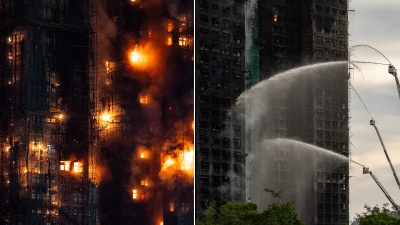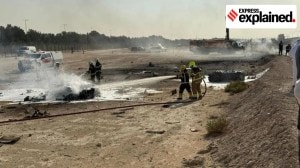Warmer, windier: why post-Diwali Delhi air was cleaner this year
The post-Diwali 24-hour average Air Quality Index (AQI) was 339 on Friday, which was better than 358 on the day after Diwali in 2023 (November 13), according to Central Pollution Control Board (CPCB) data.
 The average PM10 level was recorded at 288.6µg/m3 on Thursday at midnight, and jumped to 322.6 µg/m3 on Friday at 6 am. However, it dropped to 308.1µg/m3 by noon. (Express photo by Praveen Khanna)
The average PM10 level was recorded at 288.6µg/m3 on Thursday at midnight, and jumped to 322.6 µg/m3 on Friday at 6 am. However, it dropped to 308.1µg/m3 by noon. (Express photo by Praveen Khanna)
The 24-hour average air quality on the day before Diwali and Diwali — Wednesday and Thursday respectively — in Delhi this year was worse than in the last two years. However, on Friday morning — the day after Diwali — the pollution level was the lowest since 2015, barring 2022.
The post-Diwali 24-hour average Air Quality Index (AQI) was 339 on Friday, which was better than 358 on the day after Diwali in 2023 (November 13), according to Central Pollution Control Board (CPCB data. The worst post-Diwali air quality day was recorded in 2021, with the AQI at 462.
Why were pollution levels low on Friday?
Several factors played a role, but meteorological conditions had the biggest impact.
WARMER TEMPERATURES: Last year, Diwali was in November, when the temperature conditions were much cooler — the monthly average minimum was 13 degrees Celsius and the maximum was 27.8 degrees Celsius.
This year, however, the festival was celebrated in late October, when temperatures were much warmer. In fact, this October was the warmest in 73 years, according to the India Meteorological Department (IMD).
 Illuminated Kamla Nagar market ahead of Diwali festival in New Delhi on Monday. (Express Photo by Praveen Khanna)
Illuminated Kamla Nagar market ahead of Diwali festival in New Delhi on Monday. (Express Photo by Praveen Khanna)
The monthly maximum and minimum averages recorded at the city’s Safdarjung weather station in October were 35.1 degrees Celsius and 21.2 degrees Celsius respectively. This was the fourth-highest monthly day temperature and the sixth-highest monthly night temperature in the month recorded since 1901.
This is significant, as cooler temperatures mean increased pollution levels. As temperature dips, the inversion height — which is the layer beyond which pollutants cannot disperse into the upper layer of the atmosphere — is lowered. The concentration of air pollutants increases when this happens.
STRONG WINDS: Another factor was high wind speeds, which led to a better dispersal of the pollution post-Diwali.
According to IMD, westerly winds of speed as low as 3 to 7 kmph were observed until Friday early morning, and they touched 10 kmph by 9 am. The wind speed increased to 15 kmph from noon onward. An average wind speed of 10 kmph is considered favourable for the dispersal of pollutants.
 Smog seen early morning in Delhi-NCR. (Express photo by Praveen Khanna)
Smog seen early morning in Delhi-NCR. (Express photo by Praveen Khanna)
Due to the stronger winds, levels of tiny pollutants such as PM2.5 and PM10, which had spiked on Thursday likely due to the bursting of crackers and stubble burning in Punjab and Haryana, dropped the next day. For instance, the 24-hour average PM2.5 level was 144.3 micrograms per cubic metre (µg/m3) on Diwali at 8 pm, but had increased sharply to 168.4 µg/m3 by midnight. It gradually increased further until 7 am on Friday to 209.1µg/m3, as recorded by the CPCB, and then reduced to 198.1 µg/m3 at 4 pm.
The average PM10 level was recorded at 288.6µg/m3 on Thursday at midnight, and jumped to 322.6 µg/m3 on Friday at 6 am. However, it dropped to 308.1µg/m3 by noon.
 The wind speed increased to 15 kmph from noon onward. An average wind speed of 10 kmph is considered favourable for the dispersal of pollutants.
The wind speed increased to 15 kmph from noon onward. An average wind speed of 10 kmph is considered favourable for the dispersal of pollutants.
Anumita Roychowdury, Executive Director, Research and Advocacy at the Centre for Science and Environment, told The Indian Express, “This time, Diwali was in October, when cooler meteorological conditions had not settled in yet. The wind speed was also favourable to help dissipate the pollution build-up after Diwali midnight. Till afternoon on Diwali day, the air quality remained ‘poor’ and then worsened to ‘very poor’ in the evening. Severe AQI levels were observed at midnight and persisted till 7 am in many stations. The night-time pollution related to Diwali caused a high buildup in PM2.5 levels. Though we cannot quantify the contribution of firecrackers specifically, several sources came into play.”
- 01
- 02
- 03
- 04
- 05






































